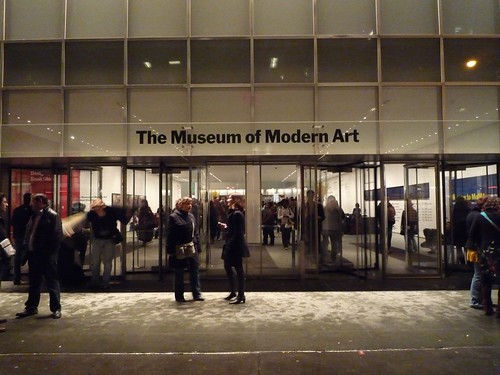
MOMA, 11 West 53st
And now for something completely different. On the second floor of the MOMA is a video installation by an artist I'd never heard of, but the show's closing soon so hurry up. Pipilotti Rist is a Swiss multimedia artist who has turned the second floor atrium into a wildly hypnotic cathedral/opium den. Visitors are encouraged to take off their shoes and sit or lie on the iris shaped (looked like an oval to me) sofa in the middle of the room, while a slow motion video is projected on three of the atriums walls. Strange mantra-like humming music is played as the visitors are treated to an ocean of color and light. We see human bodies, flowers, dirt, day glow pigs, worms, and floating green strawberries moving slowly across the walls. Many of these natural forms turn into big abstract blocks of color. A lot of the images are immersed or floating in water. Water, in fact seems to be a major theme in this work, and it adds to the relaxing womb like quality of the installation. Some have suggested that the oval shaped sofa creates the feeling of being in the middle of a giant vagina. I didn't get that, but I wasn't really looking for it either.
The thing that really struck me about Ms Rist's installation is how much fun it is. I saw a lot of children running around laughing and a lot of adults collapsing on the floor and rolling around as if tripping on some psychedelic drug. This idea of art as hallucinogen is an interesting one, and one that has a strong historical precedent. You can find it in Blake, and Bosch and later in a number of the surrealists. Today you can see it in a few of Rist's contemporaries like Philip Taaffe, Fred Tomaselli and Matthew Barney. There's a school of thought that believes art is supposed to take you out of your conscious mind, and into your subconscious or unconscious or into some elevated spiritual state. In a way Rist uses these unconventional means to explore one of arts great conventions. In this sense Ms Rist's installation serves the same function as an early renaissance religious icon. It's both a catalyst for spiritual enlightenment and a child friendly peyote trip.
The thing that really struck me about Ms Rist's installation is how much fun it is. I saw a lot of children running around laughing and a lot of adults collapsing on the floor and rolling around as if tripping on some psychedelic drug. This idea of art as hallucinogen is an interesting one, and one that has a strong historical precedent. You can find it in Blake, and Bosch and later in a number of the surrealists. Today you can see it in a few of Rist's contemporaries like Philip Taaffe, Fred Tomaselli and Matthew Barney. There's a school of thought that believes art is supposed to take you out of your conscious mind, and into your subconscious or unconscious or into some elevated spiritual state. In a way Rist uses these unconventional means to explore one of arts great conventions. In this sense Ms Rist's installation serves the same function as an early renaissance religious icon. It's both a catalyst for spiritual enlightenment and a child friendly peyote trip.

No comments:
Post a Comment